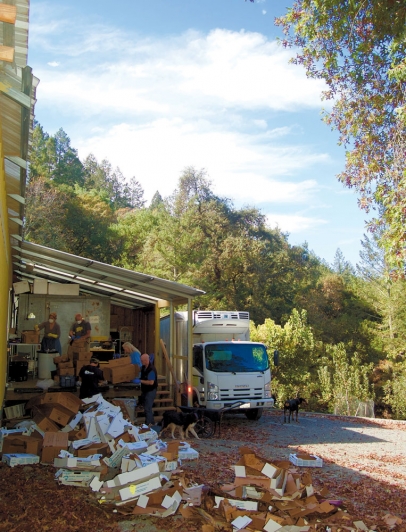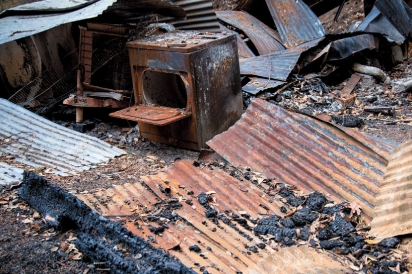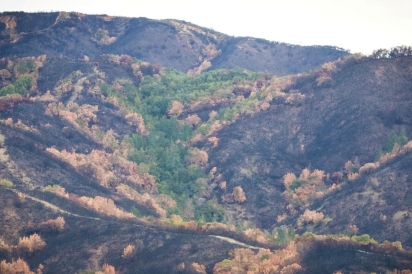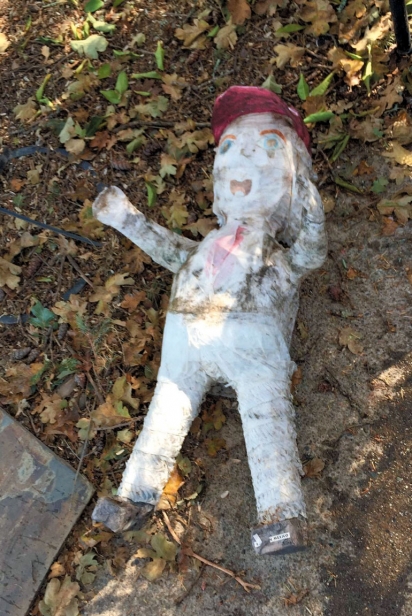The Forager and the Fire
MISSIVES FROM MT. VEEDER
The deer were bounding like blown leaves Under the smoke in front the roaring wave of the brush-fire; I thought of the smaller lives that were caught. Beauty is not always lovely...
—THE SELECTED POETRY OF ROBINSON JEFFERS
The invaluable, precious nature of having relationships with the people near you isn’t as common as it used to be and it’s extraordinary. And there’s the issue of the humility and joy of marrying a place. It isn’t a fling or a brief affair; you’re actually marrying a place and taking the downside with the good and truly acknowledging, accepting and working with the downside.
—CONNIE GREEN, FAMED FORAGER AND FOUNDER OF NAPA’S WINE FOREST WILD FOODS, MT. VEEDER, 2017
In my dreams, I could feel the knobs on my old stove and the gently warmed clay pots. Awake, my feeling is I’m not done cooking in that kitchen ... too many dishes to cook ... too many people I want to see around that table again.
—STEVE SANDO, FOUNDER OF NAPA’S RANCHO GORDO NEW WORLD SPECIALTY FOOD AND GUARDIAN ANGEL OF HEIRLOOM BEANS, MT. VEEDER, 2017
When I heard the fires had reached Napa’s Mt. Veeder I immediately thought of Connie Green’s beautiful collection of cocktail shakers and the morning she used an antique crystal and silver shaker to mix a perfect batch of Southern Milk Punch—a lovely drink consisting of bourbon, sugar, milk and a bit of nutmeg. We were two former Southern gals enjoying the punch on her patio and admiring the lush view of Mt. Saint John (the tallest mountain in the Mayacamas range) across the way. It was 2014 and I was interviewing her for an article in this magazine about life on the mountain; her business, Wine Forest Wild Foods; and her passion for foraging.
She and her late husband, Tony, had searched the West Coast in 1974, finding home on Mt. Veeder. It was there that Tony taught her to forage. Geography was destiny and Connie became connected to every animal, vegetable, mineral and human she met on the mountain.
I found myself back there soon after the October 2017 fires reached the edge of that very patio. I came to document the cadre of caring chefs helping Connie dispose of a heartbreaking number of boxes of wild mushrooms, the bulk of her business, in various states of decay, as well as crates of fragrantly fermenting huckleberries. Wine Forest Wild Foods’ refrigeration units had been without power for almost two weeks by that time.
Connie’s home and cocktail shakers had survived the fire, as did the home of her friend and the owner of Napa’s Rancho Gordo, Steve Sando. The fire had encircled both properties. Steve lost his barn and some out buildings, but the fire stopped literally within feet of the propane tank next to Steve’s mother’s home just across the street. A giant manzanita next to Connie’s house burned down to the ground, somehow without setting the house on fire. The only explanation was that, for exactly the right period of time, the constantly changing wind blew the flames away from the house. I imagined that Edesia, the Roman goddess of food who presides over feasts, took a stand there, knowing how many feasts large and small had been cooked and shared with sacred abandon by Connie and Steve on this spared “island.”
After hours of spreading rotting mushrooms around the property, returning mycelial nutrients to the soil and breaking down soggy boxes, the group gathered to share a meal. Everyone had brought favorite dishes and wine to share. We sat on the patio with a sense of satisfaction, the air still heavily scented with smoke, and thick white ash and blackened trees now a part of a stunning survivor’s view.
N95 facemasks pushed to the top of heads, latex gloves discarded, the slightly disheveled group of culinary stars served food, poured wine and shared their stories of the fires. Chef Hiro Sone and his wife, Chef Lissa Doumani, partners in Napa Valley’s Terra, offered a Japanese potato salad and stories of Lissa’s father Carl Doumani. Lissa had searched without finding him as the fires broke out, learning later that the 80-plus-year-old iconic vintner and founder of Stag’s Leap Winery had stayed on his property, dug in and fought the fire with garden hoses. Also gracing the table was Staffan Terje, chef and owner of San Francisco’s Perbacco; Chef Todd Humphries, the chef and cofounder of Kitchen Door in Napa; and Chef John Gerber, a veteran of the French Laundry.
There was talk of loss and uncertainty, and the best mayonnaise for making potato salad ( Japanese Kewpie mayo and Hellman’s) and how to make pimento cheese. A common theme was how dangerous and frightening it was that there was little to no communication available during the fires. Cell service was out in many areas of Napa and Sonoma counties, and the AT&T landlines that rural areas rely upon were not working.
There was acknowledgement of the capricious nature of the fires—a paper Trump piñata in Connie’s yard survived, while many neighbors’ homes did not. No one at the table had lost their home, but all marveled at the resilience of their friends who lost everything.
As dusk was falling I said my goodbyes and left feeling shaken and awed—by nature, and by the humbled and grateful humans who had just shared a feast with me amongst the blackened trees.
I understood that Connie’s deep connection to the mountain and her community would lend her a unique perspective on the fires, and she had graciously agreed to share her journey with me over the next few months.
One of the things I wanted to know from Connie was if she had been worried about fires when she and Tony moved there, lacking legacy memory as a new generation on the land. She shared, “There was a man named Pete Wall, a subsistence farmer and beloved neighbor. Tony and I bought 25 acres right below his house. I felt like a little girl following around a wise old man. I was in my late 20s and new to the area and I was hanging around with Pete helping him feed his cows and such. He had lived through a huge fire in 1964 and indoctrinated me with his knowledge of fire—why you should get deeply nervous in September when the winds came. People who weren’t from there would just think the land had always looked the way they were seeing the land.”
I was curious to know more about Wall and found a 1974 newsletter of the Dry Creek–Lokoya Fire District Association that mentions how seriously Connie’s former neighbor and mentor took fires on Mt. Veeder. “Over fifty-five miles of fire trails are maintained and mapped ... Pete Wall ... spent many days walking these trails and directing the bulldozer operators.” So it seems that Wall’s legacy is that, when another great fire came 43 years after that was written, his protégé Connie, his children and other Mt. Veeder neighbors were alive. But other homes on Mt. Veeder did not survive this 2017 fire, and for all who evacuated from the area in October, it was a harrowing wait for news.
“A group of us happened to meet by accident driving up to where the road was barricaded near the Dry Creek–Lokoya firehouse,” Connie continued. “We agreed to meet there at 10 every morning, which we did, hoping for news. We would hunker down to be around each other, talk and share information. We couldn’t be bothering them [the firefighters] with ‘Is our house still there?’ We kept watching the satellite maps throughout the day as they were updated. We would see fire all around and our [Connie’s and Steve’s] places would still be standing. We thought it might be an anomaly, or how they updated that section. There was a morning when we looked at the maps and the crosshatching was now over our homes. We’d escaped until then. That’s when we believed that we had run out of luck, but the luck was still there. The maps didn’t reflect our little island in the fire.”
“Our group all talked openly about our own imagined outcomes. Most of us started with the scenario that your house has burned down. In my case I thought, ‘Well, now I can do what I really want to do. I can have the house rebuilt in a way that it faces the view.’ I thought of all of these positive things to do. And this was a commonplace occurrence where people were imagining that. It just revealed a great deal about people’s individual minds and characters as to how they reacted to our situation. I was impressed and proud of our neighborhood, because people were positive. We all knew that at least one of us was going to have our house burn down and, the way things were looking, maybe all of our houses had already burned down. We were a pretty tight neighborhood through this.”
During this waiting, one of Connie’s close mushroom-forager buddies let her know that a friend of his was in the area doing transport for the fire crews and would go check on her home. Arriving, “He found the firefighters at my home and they were from this little town of Graeagle. He took pictures of my place and sent them to me. It was the first proof that my house was still standing. When I did get back here all the extra metal chairs that I normally store by the woodpile for when I have a party were set up around my big outside metal table. It seemed that this was a sanctuary where they could sit and eat lunch or rest a bit.”
Her reaction on seeing her home again once the evacuation order was lifted? “I was shocked that there were no birds, no wildlife at all. I was astonished at how still and quiet it was. On day three there were birds—they were vultures. When I’ve hunted morels, which proliferate after a fire, one of the tragic things you see are animal skeletons and the signs of death. The vultures come for that. A few days later the deer started to arrive; I still had apples and green grass in my orchard area—it became an island for the deer. Then the other birds began to return.”
Steve Sando recounted, “Literally the first thing I did when I got back in the house was to make nectar for my hummingbird feeders. They arrived within hours.” Steve also shared that the University of Guadalajara (Mexico) had done a study on reforestation after fires, finding that hummingbirds were some of the first pollinators to return. I was struck by the image of the vulture and the hummingbird working together.
I asked Connie how this might impact her local food-foraging business and she said that she wouldn’t know for a while. “This will be a whole new experience for me, with the live oaks that host our Bay Area chanterelles. There has never been a fire in my 35 years of picking chanterelles here. They live in harmony and in symbiosis with the trees. That is all over when the tree dies. That marriage is broken. It’s like the husband and wife both died. The marriage is gone.”
As I started to write this article, I returned to Connie for her observations 11 weeks after the fires. “One of the things I’m keenly aware of from morel hunting is that fires burn differently and at times extremely hot. If a black zone remains black after rains or a period of time, that tells me that it burned so hot that it burned all the way to mineral soil and no seeds remain. It is sterilized soil. I’ve been surprised how many of the black spots remain in our area after the rains and a number of weeks.” She doesn’t know in what ways it will regenerate and mused, “The issue of cleansing is a hard thing for humans to take. I know I thought ‘Come spring, this place will be beautiful again,’ and it will be, but it’s going to take a lot longer than a season. It can be a frightening thing for us as humans because we can see destruction like this and recognize that it will not always be healed in our lifetime or return to its previous form.”
When I talked to Steve Sando about his experience during and since the fires, he spoke often about “trying to find what ‘back to normal’ might look like, knowing things would never be the same.” For him it came when he, his mother and his son sat down to their first meal back home at the dining table he had dreamed about. “Almost back to normal. The Sunday supper tradition continues,” his Facebook post read.
In our last conversation, Connie shared, “It sort of haunted me knowing that firefighters gathered around my table outside and dragged those chairs over to take a break. And two or three weeks later all these chefs are there helping me dump all of that mess and we’re sitting out drinking, you know, every bottle of wine we can get our hands on. In the same place where help follows help. It was pretty wonderful for me.”
In the aftermath of the 2017 Wine Country fires, it is clear that while nature certainly has the ability to humble humans, as well as to provide for them, humans also have the ability to love and care for each other, and the land.








